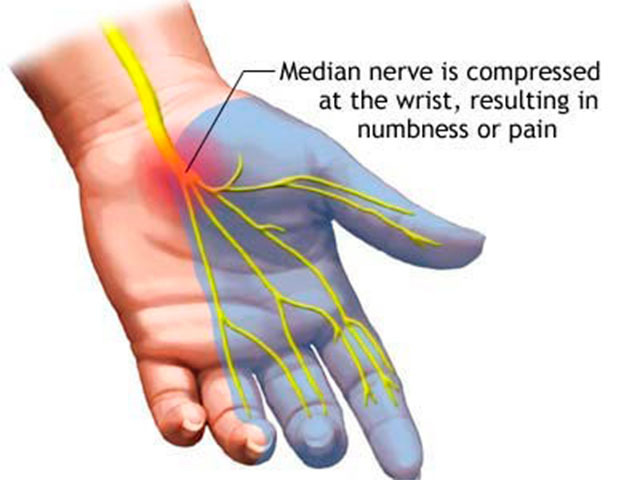The Carpal Tunnel is the name for the area in the wrist on the palm-side of the hand, where nine flexor tendons for the wrist and fingers and one major nerve pass through this ‘tunnel’. The walls of this tunnel are the bowl shaped wrist bones on the bottom, and a fairly thick type of tissue reaching across this bowl on the top half holding the tendons and nerve in place. Under normal conditions, the tendons can glide through the tunnel without any problems and do not affect that nerve, called the median nerve.
Symptoms and Diagnosis
The Symptoms are, especially at the beginning of the disease, not very specific. One of the first signs normally is tingling in the thumb, index and middle finger, sometimes involving even half of the ring finger, and it is often first noticed at night. Being confused with the ‘sleeping hand’ after having lain on the arm in an awkward position, these symptoms are normally ignored. The next level in the chain of symptoms are pins and needles in the area described above, followed by numbness and than by increasing pain in the fingers and the wrist. In this stage, the patient will also notice weakness and loss of control i.e. when picking small things up and dropping them.
The Median Nerve is one of three major nerves to the hand, responsible for sensation and movement of the thumb, index and middle finger and half of the ring finger. Like every big nerve it tolerates temporary pressure, but it cannot regenerate any damage suffered by injury or compression. There are several reasons like direct injury, elbow dislocations, compression by tumour, haematoma (bruise) in the forearm, or neck injuries for causing median nerve symptoms. Apart from these acute problems, chronic diseases like rheumatoid and osteo-arthritis can also damage the nerve. Misleading in finding the diagnosis is the fact that a nerve can show symptoms of damage in any area along its path, down from the spine to the end of the limb, regardless where the origin of the problem is.
Dr. Alf Neuhaus, orthopaedic surgeon trained in hand surgery, would perform a thorough physical exam of both hands and arms, including the neck if needed, and use some specific clinical tests (Phalen test, Hohmann- Tinnel) to evaluate the existence and the degree of the carpal tunnel syndrome. Nerve conduction studies are not needed to diagnose this disease and are often misleading, but radiographic images and ultrasound scan might be taken of both wrists for comparison, using the clinic facilities, to exclude any structural pathology that might cause the pressure on the nerve.
Treatment
The Treatment is normally straight forward, but unfortunately the diagnosis of this disease is regularly missed by misinterpreting the symptoms. In the early stage, although that could mean years after the first symptoms occurred, orthopaedic surgeon Dr. Alf Neuhaus would perform at least one local injections and with cortisone and local anaesthetics to reduce inflammation. Sometimes a night splint is applied to help with the symptoms. If this does not improve the situation or if the disease is already in the advanced stage of pain, numbness and weakness, surgical release of the carpal tunnel is recommended. This would be done by orthopaedic surgeon Dr. Alf Neuhaus as out-patient procedure in Clinica SANDALF under a local anaesthetic. Under normal circumstances, the pain and numbness settle down within a few days and the patient can return to normal life after 2 – 4 weeks.
If treatment of the carpal tunnel syndrome is started in the ‘early’ stage of the disease, full recovery of the endangered nerve can be achieved. But even in the later stage, improving the symptoms by surgically releasing the tight carpal tunnel can help in the managing of daily activities and restore a certain quality of life. Please don’t hesitate to get in touch with us for further information or to make an appointment.

